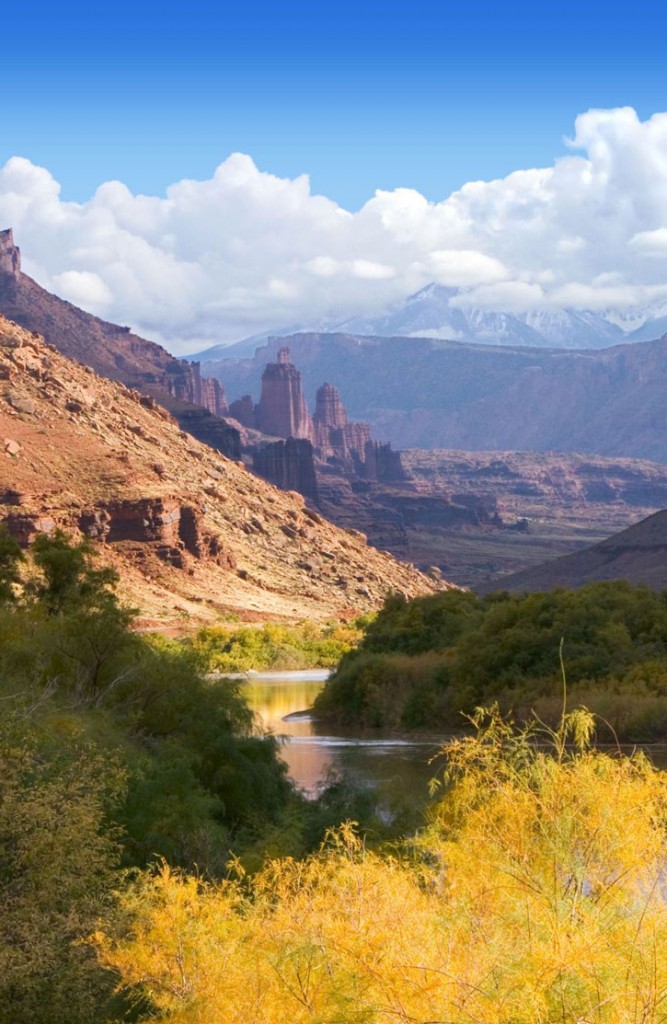
Nonnative Tamarisk trees growing on the banks of the Colorado River in Utah. Photo © Michael G. Smith/123rf.
ATVs are the new “extreme sports” toy of choice, and towns like Moab are now seeing more visitors coming to tear up the backcountry on ATVs than to mountain bike.The main environmental threats to the parks are the consequences of becoming too popular. During the summer, auto and RV traffic can clog park roads, with particularly bad snarls at viewpoint parking areas. Both Zion and Bryce have made attempts to control park traffic by running shuttle buses along scenic drives. At Zion, it’s mandatory to ride the bus (or your bike) during the summer high season, and that has made a significant difference.Hikers also have an impact, especially when they tread on fragile cryptobiotic soil. Killing this living soil crust drastically increases erosion in an already easily eroded environment.
Off-road vehicles, or ATVs (all-terrain vehicles), have gone from being the hobby of a small group of off-road enthusiasts to being one of the fastest-growing recreational markets in the country. Although use of ATVs is prohibited in the national parks, these dune buggies on steroids are having a huge impact on public lands adjacent to the parks and on Bureau of Land Management (BLM) lands that are currently under study for designation as wilderness. The scope of the issue is easy to measure. In 1979 there were 9,000 ATVs registered in Utah. In 2010 there were over 120,000. In addition, the power and dexterity of the machines has greatly increased. Now essentially military-style assault machines that can climb near-vertical cliffs and clamber over any kind of terrain, ATVs are the new “extreme sports” toy of choice, and towns like Moab are now seeing more visitors coming to tear up the backcountry on ATVs than to mountain bike. The problem is that ATVs are extremely destructive to the delicate natural environment of the Colorado Plateau deserts and canyon lands, and the more powerful, roaring, exhaust-belching machines put even the most remote and isolated areas within reach of large numbers of potentially destructive revelers.
Between the two camps—one that would preserve the public land and protect the ancient human artifacts found in remote canyons, the other that sees public land as a playground to be zipped over at high speed—is the BLM. The Moab BLM office has seemed to favor the ATV set, abdicating its role to protect the land and environment for all. Groups like Southern Utah Wilderness Alliance (SUWA) are constantly strategizing to force the BLM to comply with its responsibility for environmental stewardship of public land.
Nonnative species don’t respect park boundaries, and several nonnative animals and plants have established strongholds in Utah’s national parks, altering the local ecology by outcompeting native plants and animals.
Particularly invasive plants include tamarisk (salt cedar), cheatgrass, Russian knapweed, and Russian olive. Tamarisk is often seen as the most troublesome invader. This thirsty Mediterranean plant was imported in the 1800s as an ornamental shrub and was later planted by the Department of Agriculture to slow erosion along the banks of the Colorado River in Arizona. It rapidly took hold, spreading upriver at roughly 12 miles per year, and is now firmly established on all of the Colorado’s tributaries, where it grows in dense stands. Tamarisk consumes a great deal of water and rarely provides the food and shelter necessary for the survival of wildlife. It also outcompetes cottonwoods because tamarisk shade inhibits the growth of cottonwood seedlings.
Courthouse Wash in Arches is one of several sites where the National Park Service has made an effort to control tamarisk. Similar control experiments have been established in nearby areas, mostly in small tributary canyons of the Colorado River.
Excerpted from the Sixth Edition of Moon Zion & Bryce.